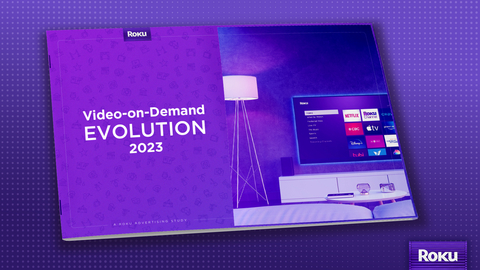More Than Half of Canadian TV Streamers Now Stream Ad-Supported TV
Roku's third annual Video-on-Demand Evolution study reveals significant changes in Canadian TV streaming habits.
- 76% of Canadians are now TV streamers, with 18% considering downgrading or canceling cable subscriptions.
- Ad-supported TV is growing, with over 52% of streamers engaging with it.
- 47% of respondents aim to change their streaming service selection due to economic factors.
Flexibility in content consumption is crucial, as 57% feel they have less disposable income. The rise in live TV viewership is notable, with a 19% increase since 2020. This shift presents opportunities for marketers to reach audiences effectively.
- 76% of Canadians are TV streamers, indicating strong market penetration.
- 52% of streamers are watching ad-supported TV, demonstrating growth in this segment.
- TV streamers are engaging more with ads, with 76% taking measurable actions post-ad viewing.
- 18% of Canadians plan to cancel or downgrade their cable subscriptions, indicating potential revenue loss for traditional providers.
- 47% of streamers are considering changes to their streaming services due to economic pressure, which may affect overall subscription revenues.
“FlexiVODs” emerge: 47 per cent of TV streamers are considering changing streaming subscriptions
- 76 per cent of Canadians are now TV streamers, and 18 per cent plan to cancel or downgrade their cable or satellite package
- More than half of Canadian TV streamers watch ad-supported TV

Roku’s annual Video-on-Demand Study (Photo: Business Wire)
The current macro-economic situation seems to have had an impact on Canadian TV households, with 18 per cent planning to cancel or downgrade their cable/satellite package in the next 12 months, and 47 per cent of respondents looking to make some changes to the selection of TV streaming services they use.
“For Canadian TV streamers, flexibility for the type of entertainment they want, anytime they want, is what makes streaming so appealing,” said
Streaming shifts and the FlexiVOD emergence in
Whether they’re downgrading from paid to free, upgrading from free to paid, or even resubscribing to services, TV streamers are on the move. With more services available than ever before, consumers carefully pick and choose what they pay for. This FlexiVOD trend is likely influenced by the fact that 57 per cent of TV streamers feel they have less disposable income than before.
When it comes to content, live TV is winning popularity, with 49 per cent of Canadians watching live TV such as sports and other key events on demand through TV streaming. This is a significant increase from 30 per cent using VOD services to stream live TV in 2020.
The rise of ad-supported TV: A deeper dive
As ad-supported TV popularity grows, Canadian TV streamers are spending five hours per week with it (an increase of 14 per cent year-over-year, which also includes BVOD). The majority (76 per cent) are also taking measurable actions such as searching for more information, visiting the brand, adding to basket, and more after seeing the ads.
When it comes to consumer preferences for TV advertising, nearly half (48 per cent) of streamers under 35 say they prefer when the tone of a TV ad matches the program in which they see it; and 47 per cent say they’re more likely to pay attention to ads that reflect or are relevant to their mood. Some Canadians are also interested in engaging with ad formats such as QR codes.
“TV streamers are more responsive on streaming platforms to ads than non-TV streamers who see ads on TV, which can be attributed to the lighter ad-load through TV streaming,” said Summers. “Channels like The Roku Channel, Roku’s own ad-supported TV streaming service, make OTT advertising a better prospect for everyone involved – it’s a win-win for everyone in the TV streaming ecosystem.”
Additional insights:
- 29 per cent of streamers are “Cord Nevers,” i.e., consumers who have never paid for cable.
- The average age of monthly TV streamers is 44.
- More streamers are collectively watching programming with subtitles – 86 per cent of anglophone streamers and 64 per cent of francophone streamers – compared to dubbed content.
To learn more about the study, and to download the full report, please click here.
About Roku’s
Roku’s 2023 Video on Demand (VOD) Evolution study examined Canadian TV streaming behaviour and trends. This is Roku’s third study of Canadians’ TV streaming habits, and an update to its research in 2020 and 2021. Like those, this study is based on the results of an online survey of Canadian adults aged 18+ who use the internet and watched TV at least once in the last month. Fuse Insights research commissioned by Roku took place between July and
About
Roku pioneered streaming to the TV. We connect users to the streaming content they love, enable content publishers to build and monetize large audiences, and provide advertisers with unique capabilities to engage consumers. Roku streaming players and TV-related audio devices are available in the
This press release contains “forward-looking” statements that are based on our beliefs and assumptions and on information currently available to us on the date of this press release. Forward-looking statements may involve known and unknown risks, uncertainties and other factors that may cause our actual results, performance or achievements to be materially different from those expressed or implied by the forward-looking statements. These statements include but are not limited to those related to the growth and adoption of TV streaming and the global trend towards streaming, including trends towards streaming among Canadians. Except as required by law, we assume no obligation to update these forward-looking statements publicly, or to update the reasons actual results could differ materially from those anticipated in the forward-looking statements, even if new information becomes available in the future. Important factors that could cause our actual results to differ materially are detailed from time to time in the reports
Roku is a registered trademark of
View source version on businesswire.com: https://www.businesswire.com/news/home/20230119005039/en/
etenuta@roku.com
APEX PR
dscott@apexpr.com
Source:
FAQ
What are the key findings of Roku's 2023 Video-on-Demand Evolution study?
How many Canadians are planning to cancel or downgrade their cable subscriptions?
What percentage of Canadian TV streamers watch ad-supported content?
What is the impact of economic factors on Canadian TV streaming habits?







